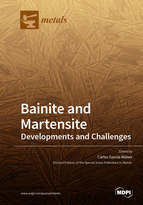Bainite and Martensite: Developments and Challenges
A special issue of Metals (ISSN 2075-4701).
Deadline for manuscript submissions: closed (31 May 2017) | Viewed by 90805
Special Issue Editor
Interests: steels; microstructural characterization; phase transformation; mechanical properties; mechanical behavior of materials
Special Issues, Collections and Topics in MDPI journals
Special Issue Information
Dear Colleagues,
Nowadays, when modern high strength steels come to play, it is not strange to find that their microstructure contains austenite and either bainite or martensite, a combination of both, or more sophisticated variations such as Q&P and nanostructured bainitic steels.
There is no doubt that there are certain similarities in the mechanisms ruling such transformations, and therefore it is not surprising that parameters at play controlling the mechanical properties also overlap.
The development of new and powerful scientific techniques and equipment (EBSD, APT, HRTEM, etc.) allow us to gain fundamental insights that help to establish some of the principles by which those microstructures are known. The developments accompanying such findings lead to further developments and intensive research providing the required metallurgical support.
There is a very significant number of publications and some scattered conferences and workshops devoted to these type steels. However, there is no forum that brings together the latest developments, taking place in the framework of these microstructures and their properties.
Papers on recent advances and review articles, particularly related to the most challenging aspects of the use of bainitic and martensitic microstructures, in any of their forms, are invited for inclusion in this Special Issue on "Bainite and Martensite: Developments and Challenges".
Dr. Carlos Garcia-Mateo
Guest Editor
Manuscript Submission Information
Manuscripts should be submitted online at www.mdpi.com by registering and logging in to this website. Once you are registered, click here to go to the submission form. Manuscripts can be submitted until the deadline. All submissions that pass pre-check are peer-reviewed. Accepted papers will be published continuously in the journal (as soon as accepted) and will be listed together on the special issue website. Research articles, review articles as well as short communications are invited. For planned papers, a title and short abstract (about 100 words) can be sent to the Editorial Office for announcement on this website.
Submitted manuscripts should not have been published previously, nor be under consideration for publication elsewhere (except conference proceedings papers). All manuscripts are thoroughly refereed through a single-blind peer-review process. A guide for authors and other relevant information for submission of manuscripts is available on the Instructions for Authors page. Metals is an international peer-reviewed open access monthly journal published by MDPI.
Please visit the Instructions for Authors page before submitting a manuscript. The Article Processing Charge (APC) for publication in this open access journal is 2600 CHF (Swiss Francs). Submitted papers should be well formatted and use good English. Authors may use MDPI's English editing service prior to publication or during author revisions.
Keywords
- Phase transformation
- Modelling
- Alloy and process design
- Thermal treatment
- Mechanical and in-use properties
- Crystallography
- Microstructural (advanced) characterization






